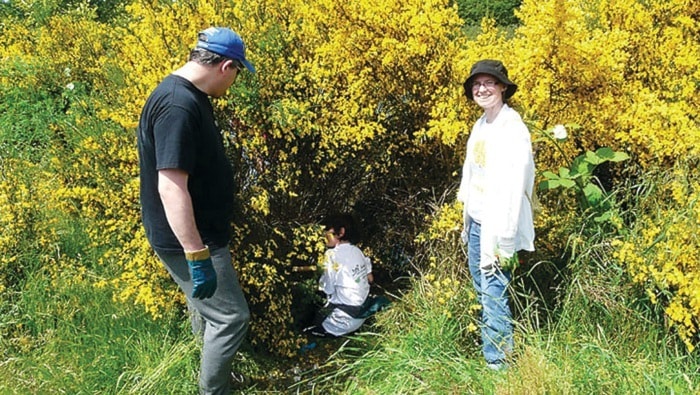Greenways Land Trust and Tim Hortons invites you to join them Saturday, from 10 a.m. until 1 p.m. at the Myrt Thompson Trail on the Campbell River Estuary in an effort to reduce Scotch Broom from these ecologically sensitive lands.
The Annual Broom Bash is once again targeting Scotch Broom. Do your part with Greenways Land Trust and Tim Hortons to help celebrate Earth Week in a meaningful way by helping to rid our estuary of invasive species.
Scotch Broom competes with native species for available light, moisture and nutrients, especially on disturbed sites. It alters ecosystems in such a way as to prohibit other plants from taking to land post-disruption, in return reducing biodiversity and dominating the landscape.
Greenways Land Trust, an environmental non-profit organization, has been battling this fast growing, noxious weed throughout the Campbell River area for 12 years through their annual Broom Bash. Now in its 13th year, the volunteer event will be held at the Myrt Thompson Trail in the Campbell River estuary. It is located at the end of Maple Street (behind the Quinsam Hotel).
Tim Hortons has partnered in this project, providing assistance to Greenways, plus tools, t-shirts, and Timbits to volunteers. Everyone is welcome to join in the ripping and clipping of Broom along the estuary.
Scotch Broom, Cytisus scoparius, is native to the Mediterranean areas of Europe. It was intentionally introduced to B.C. in 1850 by Captain Walter Grant who planted broom at his farm on Vancouver Island in 1850. Regrettably, few realized the invasiveness of this perennial as it quickly spread up the east coast of Vancouver Island before invading the Gulf Islands and mainland. Humans encouraged its continued spread as highways departments planted Scotch broom as a bank stabilizer because of its deep root structure and rapid growth.
Often found roadside or in open meadows, a single plant can produce 3500 pods, within which there are 5-12 seeds, easily forming dense thickets of yellow that obstruct mobility and increase wildfire intensity. So far there are no known natural predators for this weed, therefore allowing it to spread throughout southern B.C. and other parts of North America. It does particularly well in recently disturbed areas, and for this reason it continues to increase in areas of Vancouver Island and the Lower Mainland where land development is intensive.
Native shrubs such as red flowering current and salmon berry will be planted on the site at the time of the Broom Bash.
For more information visit www.greenwaystrust.ca or call Stacey at 250-287-3785.
